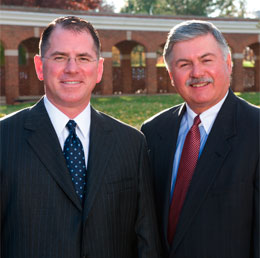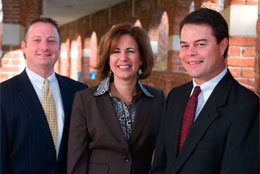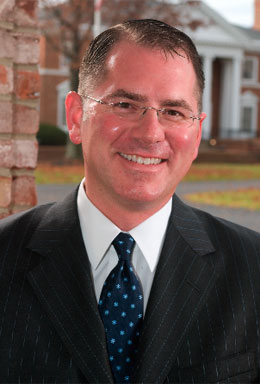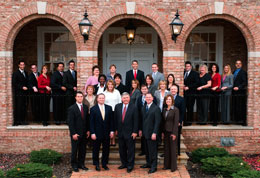|
All systems go
MarshBerry powers up to drive agency growth
By Elisabeth Boone, CPCU
Perpetuation…producer recruiting and training…leadership development…workflow processes…producer manage-ment…mergers and acquisitions… organic growth and profit…
These compelling issues likely contend for top spots on the list of challenges with which independent agency owners contend. And today the urgency of these concerns is magnified by the daunting combination of a soft market and a deepening global economic downturn with no end in sight.
Even in the best of times, managing and growing a profitable agency requires a high degree of skill, experience, judgment, and flexibility; and even owners who possess these attributes recognize the need for expert guidance.
Many of these agency owners find that guidance at consulting firm Marsh, Berry & Company, Inc. Established in 1981 by Larry Marsh and Bob Berry, the firm offers a comprehensive menu of solutions to help its agency and broker partners achieve maximum growth in value and long-term return to shareholders. MarshBerry’s 900-plus clients include retail and wholesale insurance distributors, program managers, third-party administrators, insurance carriers, and financial institutions. Organizations that are not directly engaged in insurance distribution retain MarshBerry to either acquire or access entities within the system.
Based in Willoughby, Ohio, MarshBerry serves clients in all50 states and has offices in Cincinnati, Chicago, Phoenix, Nashville; Dana Point, California; Tyler, Texas; and Grand Rapids, Michigan. The privately held, employee-owned firm operates with a staff of 55-plus.
MarshBerry President John Wepler and other key shareholders in the firm recently spoke with Rough Notes to provide insight into the mission, objectives, and accomplish-ments of this prominent consultant to various segments of the insurance distribution system.
Wepler joined MarshBerry in 1991 as a financial analyst. “While we were a smaller firm at that time, our strong commitment to help our clients drive value was there from the start and has not wavered,” he comments. “I came in to provide financial analytical support and quickly became immersed in consulting and merger and acquisition engagements.” In 1997 Wepler became executive vice president of mergers and acquisitions; at the same time he served as a management consultant. He was named president of MarshBerry in 2005.
Driving growth and value
Co-founder Larry Marsh brought to his new firm a broad background in insurance management, M&A advisory and operational consulting. “Larry established MarshBerry for four main reasons,” Wepler says. “First, he had the desire to build a world-class repository of best practices benchmarks that agencies could rely on to drive value appreciation and return to shareholders. Second, he wanted to build a firm with institutional value that would attract and retain entrepreneurs committed to crafting creative solutions to help our clients. Third, he saw an opportunity to build a full plate of consulting and advisory solutions to ensure that independent agents and brokers would not only perpetuate but thrive. Finally, he had a strong partner, Bob Berry, who shared his vision and commitment to insurance distributors.” (Berry retired from the firm in 1991.)
The MarshBerry logo (see page 87), Wepler says, embodies the organization’s philosophy and ongoing approach to serving its clients: Learn, Improve, Realize.
“Our firm’s commitment is to enable our clients to maximize long-term value appreciation and return to shareholders,” Wepler says. “Everything we do is geared toward helping our clients Learn the critical metrics and practices of peak performers, to Improve their business so that they can Realize maximum agency value—whether that value is received through an estate plan, an internal perpetuation plan, a leveraged managed buyout, a sale or merger, through dividend distributions or stock appreciation. That is our responsibility to our agency partners and what those partners rightfully demand from our firm.”
How does MarshBerry help its clients accomplish each of its three goals—Learn, Improve, Realize?
“We gather scrubbed, highly accurate, granular metrics that identify and define not only best practices but proven practices among the peak performers in the industry,” Wepler says. “We use those metrics to help our clients learn those practices that will enable them to move on to the next stage, which is to improve performance and realize financial growth and profitability.
“We define improvement,” he continues, “as the execution of a business plan that maximizes predictable and profitable growth so that an agency can realize its full business potential. We are successful if we can help our clients execute such a plan. Because Learn, Improve, and Realize is the process by which we execute our consulting initiatives, all of our products, services, and personnel are stitched together to ensure the successful realization of our clients’ business objectives. Instead of looking at value enhancement through a single lens, we are able to wrap our collective arms around a client’s entire agency to help lead change.”
Menu of services
MarshBerry is organized into four operating divisions: Consulting Services, M&A Advisory Services, Exchange Network Services, and Information Services.
The Consulting division assists agencies with sales management strategies, business planning, perpetuation plans, financial consulting, operational workflow and procedures consulting, agency valuation, internal financial controls, and producer recruiting.
Consummating more than 530 transactions since its inception, the M&A Advisory division provides a full spectrum of services related to agency mergers and acquisitions, from planning and agency valuation through deal execution, due diligence, and post-closing management. Val DeMell is the executive vice president for these divisions.
A key role for MarshBerry is to provide forums in which participants can network, exchange ideas, and discuss strategies in confidence through a structured process that is based on a critical review of concrete benchmarks. These CEO peer groups not only help one another turn the “what” of best practices into “how” but also hold one another accountable for executing change. Albert Lloyd is executive vice president and oversees the Exchange Networks division, which operates three exchanges for agency members.
Perhaps the best known exchange network is APPEX (Agency Peak Performance EXchange), a network of more than 120 agencies representing revenue in excess of $1 billion. BANK (Bank-Agency NetworK) has more than 25 members that generate over $980 million in revenue. The TASC (Total Agency Sales Culture) Network offers enhanced new business production and retention strategies to more than 40 leading organic growth agencies that generate revenue exceeding $1.2 billion. Some agencies, Lloyd notes, belong to more than one MarshBerry network.
Lloyd also manages the Information Services division, which provides benchmarking services and carrier services aimed at (1) training carrier marketing personnel and (2) providing growth and perpetuation solutions to a carrier’s agency plant. Information Services also maintains the firm’s Web site (www.MarshBerry.com), prepares two monthly publications — “The MarshBerry Letter” and “For The Record”—and makes experts available for public speaking engagements. The division also uses its substantial body of industry data to generate forward-looking reports on issues of concern to its clients.
“Every six months we publish a white paper, which is an exhaustive research report on one particular area that we believe is revolutionizing the industry,” Lloyd says. “We are committed to publish and disseminate best in class research so that we can help our clients anticipate, understand, and exploit equity-enhancing change. Twice a year we take all of the proprietary statistics we have on $5 billion-plus in revenue and try to lay out where the industry is headed so our clients can prepare to not only survive but thrive. The white paper is literally our attempt to provide the industry with a blueprint for the future,” Lloyd asserts.
Eye on perpetuation
Thanks to its deep involvement in the insurance distribution system, MarshBerry is ideally positioned to identify and respond to emerging needs within the system.
“There are a number of voids in the industry,” claims Patrick Linnert, executive vice president of corporate development. “One of the major voids is in the number of quality perpetuation candidates and the need to bring young people into the industry.”
To help APPEX members address that challenge, Larry Marsh became vice chairman in 2005, transferring his dual role as chairman and CEO to Doug Yoh. Marsh now has the time to focus intensively on the Mentoring and Apprenticeship Program for Leading Young Tigers (MAPLYT) program, which is described in an article titled “Building Agency Leaders” in the November 2008 issue of Rough Notes.
The program’s freshman class of 13 young producers just completed its first year of the five-year course, and MarshBerry executives are pleased with the level of enthusiasm and commitment demonstrated by this group of future leaders. “Three of the young producers in the program produced more than $300,000 in new business commission during the first nine months of 2008, but beyond that, they are all exhibiting the leadership qualities of future CEOs,” Linnert says. Marsh is also acutely focused on delivering proven perpetuation solutions to the firm’s exchange network clients.
MarshBerry’s commitment to fostering agency perpetuation, Yoh emphasizes, is firmly rooted in the firm’s own perpetuation initiative. “We’ve perpetuated our company because Larry was very good at hiring, developing, and retaining young people. He believes, and we’ve proved, that the way to drive long-term sustainability and perpetuation in the insurance brokerage business is to move toward broadening employee ownership to those who desire to assume risk in the long-term search for return,” Yoh asserts.
“Over time, Larry has diluted his ownership interest in MarshBerry and allowed key people to buy in. He’s now an 8% shareholder, and ownership is held by a total of 19 employee shareholders.”
Yoh cites two reasons why MarshBerry believes in broadening employee ownership. “First, we want our key employees to have the opportunity to become stockholders so that their success is irreversibly linked to our clients’ success. We want employees to take ownership in our success in the sense that we’re all shareholders and partners. When a client is in need of help, it is our collective responsibility. We want stock ownership to mean something; we want our employees, as we say, to ‘bleed purple,’ ” Yoh says, referring to one of MarshBerry’s signature colors.
“Second,” Yoh continues, “we believe it is critical to demonstrate to our clients that we practice what we preach and that we know first hand how to perpetuate a business. By offering company stock to key employees who accept risk, we allow them to build a retirement asset that is supported by a functioning buy-sell agreement,” Yoh explains.
“At the core of our consulting value proposition is helping our clients build an internal market for their stock as we have,” DeMell continues. “As employees become ready to sell their stock, there must be a pool of future shareholders who will be excited about the opportunity to buy that stock. The mechanisms of the buy-sell agreement must be in place to help them fund the purchase of the stock so there’s an ongoing internal transition of ownership. There must be a liquidity process that supports the perpetuation plan,” she concludes.
“We have implemented this process at our firm, and we are committed to do the same for our clients,” DeMell asserts. “In fact, the last stock offering at MarshBerry was oversubscribed; the demand for purchase exceeded the supply of stock available. While we are proud that we have built an internal market for our own stock, we believe our clients should judge us by our ability to help those agencies that are willing and able to execute their own perpetuation plan that stands the test of time.”
Challenges abound
Amid a turbulent economic climate and a prolonged soft market, the insurance distribution system faces myriad challenges that require creativity, flexibility, and the ability to balance current demands with future concerns.
“A lot of external factors represent land mines through which our clients must navigate,” Linnert says. “For many agencies, however, the internal land mines are more significant. The first one is aging ownership; the average age of agency owners is increasing dramatically.
“The second piece is profitability, or managing the margins. That requires owners to focus on operational issues and workflow procedures, as well as incentive compensation, internal financial controls, and business planning,” he continues.
A third issue, Linnert says, is organic growth management. “A lot of agencies have nonperforming producers. We work with clients to develop producer pipeline management systems, goal setting, accountability systems, activity tracking, and other coaching solutions to drive the performance of both performing and nonperforming producers.” MarshBerry’s Management Consulting division, Linnert explains, has a producer recruiting unit that helps clients search for, screen, and hire new producers from outside the industry; develop compensation plans; and offer producers technical and sales training.
Another challenge, Wepler points out, is differentiation. “What story does your agency have to tell, and what compliance audit or exception reporting processes surround the client service promise?” he asks. “We help our clients wrap their value proposition around a tangible, auditable service commitment to drive both new business production and retention.”
Today, as it has done throughout its history, MarshBerry strives to help its clients understand the issues that affect them and respond in ways that drive growth and value while assuring orderly perpetuation. *
For more information:
Marsh, Berry & Company, Inc.
Web site: www.marshberry.com
|
|
| |
 |
| |
At the helm of Marsh, Berry & Company are (from left) President John M. Wepler and Chairman/CEO Douglas A. Yoh. |
| |
 |
| |
MarshBerry executives include (from left): Patrick T. Linnert, Executive Vice President; Valerie DeMell, Executive Vice President; and Albert A. Lloyd, Executive Vice President and Executive Director of BANK. |
| |
 |
| |
“We define improvement as the execution of a business plan that maximizes predictable and profitable growth so that an agency can realize its full business potential.”
—John Wepler |
| |
 |
| |
The Ohio staff at their headquarters in Willoughby, Ohio. |
|